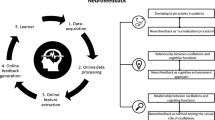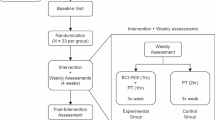Abstract
Objective
This study aims to analyze the effects of intermittent theta burst stimulation (iTBS) on motor skill acquisition of healthy subjects when applied on alternate days to ensure high adherence to treatment.
Materials and methods
Ten healthy participants (40–54 years) were included in the study. The control group (CG) (60% female) only received motor training (i.e., finger tapping task-FTTa), whereas the experimental group (EG) (100% female) received iTBS in addition to the motor training (every other day for 5 sessions). Cortical excitability measurements were taken with TMS. The correct sequences of the finger tapping test (FTTe) were recorded for behavioral analysis.
Results
While SICI was increased by 0.03 in EG, ICF was increased by 0.18 between pre-and post-treatment. On the other hand, CG had a lower ICF difference (MD: 0.05) and a higher SICI difference (MD: 0.21). There was no difference between EG and CG in FTTe at the end of the intervention (p > 0.05 for all variables), except for the increased number of correct sequences within the EG (p = 0.018). There was a significant difference in FTTa between EG and CG, in favor of EG (p = 0.042). The effect size was 0.62.
Conclusion
Although no difference was found in terms of cortical excitability and FTTe between the EG and CG at the end of the alternate-day treatment, it seemed like iTBS increased cortical facilitation further than CG. Furthermore, the number of correct sequences in FTTe and FTTa was significantly increased in EG, showing that intermittent iTBS might improve motor learning and performance.




Similar content being viewed by others
Data availability
There are no linked data sets for this paper. The data is confidential since the participant of this study was informed upon admission to the hospital that the data would remain confidential and would not be shared with third parties.
Code availability
Not Applicable.
References
Suppa A, Huang YZ, Funke K et al (2016) Ten years of theta burst stimulation in humans: established knowledge, unknowns and prospects. Brain Stimul 9:323–335. https://doi.org/10.1016/j.brs.2016.01.006
Huang Y-Z, Edwards MJ, Rounis E et al (2005) Theta burst stimulation of the human motor cortex. Neuron 45:201–206. https://doi.org/10.1016/j.neuron.2004.12.033
Czobor P, Skolnick P (2011) The secrets of a successful clinical trial: compliance, compliance, and compliance. Mol Interv 11:107–110. https://doi.org/10.1124/mi.11.2.8
Thibaut A, O’Brien AT, Fregni F (2017) Strategies for replacing non-invasive brain stimulation sessions: recommendations for designing neurostimulation clinical trials. Expert Rev Med Devices 14:633–649. https://doi.org/10.1080/17434440.2017.1352470
López-Alonso V, Cheeran B, Fernández-del-Olmo M (2015) Relationship between non-invasive brain stimulation-induced plasticity and capacity for motor learning. Brain Stimul 8:1209–1219. https://doi.org/10.1016/j.brs.2015.07.042
Platz T, Adler-Wiebe M, Roschka S, Lotze M (2018) Enhancement of motor learning by focal intermittent theta burst stimulation (iTBS) of either the primary motor (M1) or somatosensory area (S1) in healthy human subjects. Restor Neurol Neurosci 36:117–130. https://doi.org/10.3233/RNN-170774
Oldfield RC (1971) The assessment and analysis of handedness: The Edinburgh inventory. Neuropsychologia 9:97–113. https://doi.org/10.1016/0028-3932(71)90067-4
Folstein MF, Folstein SE, McHugh PR (1975) “Mini-mental state”: a practical method for grading the cognitive state of patients for the clinician. J Psychiatr Res 12:189–198. https://doi.org/10.1016/0022-3956(75)90026-6
Beck AT, Ward CH, Mendelson M et al (1961) An inventory for measuring depression. Arch Gen Psychiatry 4:561–571. https://doi.org/10.1001/archpsyc.1961.01710120031004
Ozdemir Z, Acar E, Soysal A (2021) The effects of 30 Hz, 50 Hz AND 100 Hz continuous theta burst stimulation via transcranial magnetic stimulation on the electrophysiological parameters in healthy individuals. Ideggyogy Sz 74:41–49. https://doi.org/10.18071/isz.74.0041
Stoet G (2016) PsyToolkit: a novel web-based method for running online questionnaires and reaction-time experiments. Teach Psychol 44:24–31. https://doi.org/10.1177/0098628316677643
Stoet G (2010) PsyToolkit: a software package for programming psychological experiments using Linux. Behav Res Methods 42:1096–1104. https://doi.org/10.3758/BRM.42.4.1096
Bönstrup M, Iturrate I, Hebart MN et al (2020) Mechanisms of offline motor learning at a microscale of seconds in large-scale crowdsourced data. npj Sci Learn 5:7. https://doi.org/10.1038/s41539-020-0066-9
Hinder MR, Goss EL, Fujiyama H et al (2014) Inter- and intra-individual variability following intermittent theta burst stimulation: implications for rehabilitation and recovery. Brain Stimul Basic Transl Clin Res Neuromodul 7:365–371. https://doi.org/10.1016/j.brs.2014.01.004
McLeod S (2019) What does effect size tell you? In: Simply Psychol. https://www.simplypsychology.org/effect-size.html. Accessed 20 Feb 2022
Butts RJ, Kolar MB, Newman-Norlund RD (2014) Enhanced motor skill acquisition in the non-dominant upper extremity using intermittent theta burst stimulation and transcranial direct current stimulation. Front Hum Neurosci 8:451. https://doi.org/10.3389/fnhum.2014.00451
Zhang JJ, Fong KNK (2021) The modulatory effects of intermittent theta burst stimulation in combination with mirror hand motor training on functional connectivity: a proof-of-concept study. Front Neural Circuits 15:548299. https://doi.org/10.3389/fncir.2021.548299
Chen YJ, Huang YZ, Chen CY et al (2019) Intermittent theta burst stimulation enhances upper limb motor function in patients with chronic stroke: a pilot randomized controlled trial. BMC Neurol 19:69. https://doi.org/10.1186/s12883-019-1302-x
Neva JL, Brown KE, Wadden KP et al (2019) The effects of five sessions of continuous theta burst stimulation over contralesional sensorimotor cortex paired with paretic skilled motor practice in people with chronic stroke. Restor Neurol Neurosci 37:273–290. https://doi.org/10.3233/RNN-190916
Fattinger S, de Beukelaar TT, Ruddy KL et al (2017) Deep sleep maintains learning efficiency of the human brain. Nat Commun 8:15405. https://doi.org/10.1038/ncomms15405
Song J-H (2019) The role of attention in motor control and learning. Curr Opin Psychol 29:261–265. https://doi.org/10.1016/j.copsyc.2019.08.002
Khedr EM, Etraby AE, Hemeda M et al (2010) Long-term effect of repetitive transcranial magnetic stimulation on motor function recovery after acute ischemic stroke. Acta Neurol Scand 121:30–37. https://doi.org/10.1111/j.1600-0404.2009.01195.x
Acknowledgements
The authors would like to thank Dr. Marlene Bönstrup for kindly sharing their task design. Also, our sincere thanks to Seda Nur Erol and Tülin Kesim Türkan for their great help during the study.
Funding
This research did not receive any funding from agencies in the public, commercial, or not-for-profit sectors.
Author information
Authors and Affiliations
Contributions
All authors contributed to the conceptualization, methodology, and manuscript preparation. Formal analysis and investigation were carried out by ENK, BEH, and ZÖ. The research was supervised by BEH, ZB, and AS.
Corresponding author
Ethics declarations
Conflict of interest
The authors declare that they have no conflict of interest.
Ethical approval
The study was approved by Istanbul Medipol University Clinical Trials Ethics Committee (date 17.06.2021-no.684) and administered according to the Ethical Principles for Medical Research Involving Human Subjects by the Helsinki Declaration.
Consent to participate
Both written and verbal consent was obtained from the participants before the study.
Consent for publication
It was obtained from the participant.
Additional information
Publisher's Note
Springer Nature remains neutral with regard to jurisdictional claims in published maps and institutional affiliations.
Rights and permissions
Springer Nature or its licensor (e.g. a society or other partner) holds exclusive rights to this article under a publishing agreement with the author(s) or other rightsholder(s); author self-archiving of the accepted manuscript version of this article is solely governed by the terms of such publishing agreement and applicable law.
About this article
Cite this article
Kolbaşı, E.N., Hüseyinsinoğlu, B.E., Özdemir, Z. et al. Enhancement of motor skill acquisition by intermittent theta burst stimulation: a pilot study. Acta Neurol Belg 123, 971–977 (2023). https://doi.org/10.1007/s13760-022-02155-0
Received:
Accepted:
Published:
Issue Date:
DOI: https://doi.org/10.1007/s13760-022-02155-0




